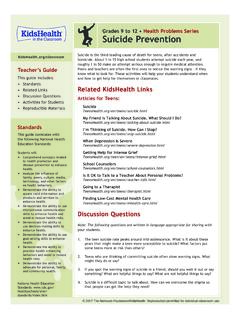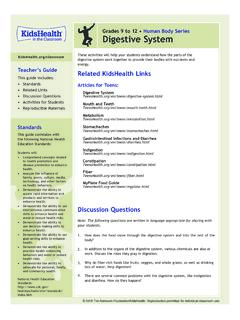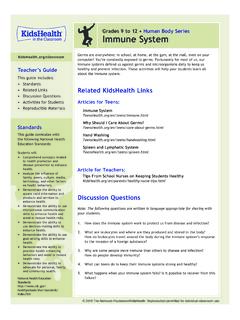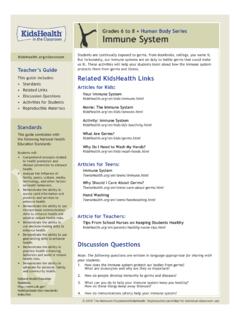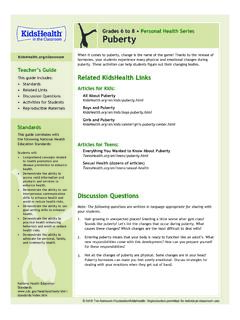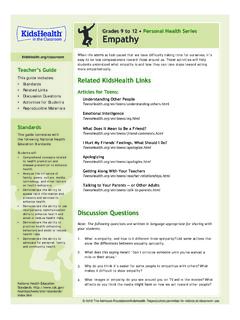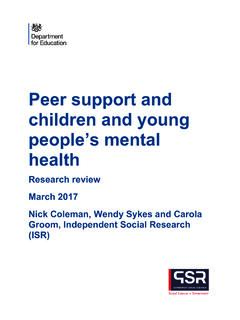Transcription of Grades 6 to 8 • Bullying - KidsHealth
1 2017 The Nemours Foundation/ KidsHealth . Reproduction permitted for individual classroom 6 to 8 Health Problems SeriesBullyingToo many students wake up every day feeling afraid to go to school. Bullying , both physical and verbal, can get extreme during the middle school years. These activities will help give your students an understanding of Bullying as well as coping skills to help protect KidsHealth LinksArticles for Middle School Students:The Scoop on Gossip World Without Bullying : Brigitte s Story With Bullying Can I Help Someone Who s Being Bullied? With Cliques I Fight a Bully? Is Spreading Rumors About Me. What Can I Do? Helped Spread a Rumor. What Should I Do? Bullied Someone. How Can I Apologize?
2 QuestionsNote: The following questions are written in language appropriate for sharing with your kinds of behaviors are considered Bullying ? Name some different waysstudents are does teasing cross the line into Bullying ? Is name-calling Bullying ? you ever been bullied? How did it make you feel? Have you ever bulliedsomeone? How did it make you feel? you ever spread a rumor? Why can spreading rumors be consideredbullying? are some of the effects Bullying can have on victims? do some students bully other students?Teacher s GuideThis guide includes: Standards Related Links Discussion Questions Activities for Students Reproducible MaterialsStandardsThis guide correlates with the following National Health Education Standards:Students will: Comprehend concepts relatedto health promotion anddisease prevention to enhancehealth.
3 Analyze the influence offamily, peers, culture, media,technology, and other factorson health behaviors. Demonstrate the ability toaccess valid information andproducts and services toenhance health. Demonstrate the ability to useinterpersonal communicationskills to enhance health andavoid or reduce health risks. Demonstrate the ability touse decision-making skills toenhance health. Demonstrate the ability to usegoal-setting skills to enhancehealth. Demonstrate the ability topractice health-enhancingbehaviors and avoid or reducehealth risks. Demonstrate the ability toadvocate for personal, family,and community health education standards: 2017 The Nemours Foundation/ KidsHealth . Reproduction permitted for individual classroom for StudentsNote: The following activities are written in language appropriate for sharing with your Against BullyingObjectives:Students will: Define and understand characteristics of Bullying Learn coping strategies for Bullying through role-playingMaterials: Computer with Internet access Acting Against Bullying handoutClass Time: Two 1-hour sessionsActivity:Chances are you ve seen somebody being bullied, you ve been bullied, or you may have even been the bully yourself.
4 After reading the articles related to Bullying , we ll divide into small groups and role-play situations in the Acting Against Bullying handout. Each skit should include at least one bully, a victim, a silent bystander (witness who does nothing in response to Bullying ), a defending bystander (witness who helps the victim), and an adult. Be sure to include at least one Bullying survival tip from the articles or another possible solution to halt the Bullying . After each skit, we ll discuss these questions as a class: Who was the bully or bullies? Who was the victim? Who was the silent bystander (witness who does nothing inresponse to Bullying )? Who was the defending bystander (witness who helps the victim)? Who was the adult?
5 How was the victim bullied? Verbally, physically, emotionally? How do you think the victim, bystander, and defender felt? Was the possible solution to the Bullying situation effective? What other solutions could be effective ways todeal with the Bullying ? Should there be consequences for the bully? students create posters, collages, poems, songs, or videos about how Bullying affects victims, victims families, bystanders, the bullies themselves, or the school community. Display the art in the hallways to sharethe anti- Bullying messages, and play the songs or videos at school students to identify potential Bullying hotspots around the school, such as hallways, stairways, lockerrooms, bathrooms, or other places that might lack a lot of adult supervision.
6 Create posters for these areas thatcite the penalties bullies face and inform victims about how to report Bullying your students each write a brief letter to the editor of your school or local newspaper about their thoughtson any aspect of 6 to 8 Health Problems SeriesBullying 2017 The Nemours Foundation/ KidsHealth . Reproduction permitted for individual classroom for StudentsNote: The following activities are written in language appropriate for sharing with your of FriendsObjectives:Students will: Identify and develop tolerance and appreciation for similarities and differences among classmates as a techniqueto diffuse Bullying Explore strategies to help promote a bully-free learning environmentMaterials: Computer with Internet access Circles of Friends handout, pens or pencilsClass Time: 1 hourActivity:People can seem very different in terms of appearance and social status.
7 Those two differences are also two of the main reasons students are bullied. But most students have similar feelings about the way they want to be treated. Understanding other people s feelings and appreciating personal differences can significantly reduce Bullying in schools. After reading the articles on Bullying and related topics, I ll assign each of you a classmate to pair up with and fill out the Venn diagram on the Circles of Friends handout. As a pair, write five ways each of you differ from the other, as well as at least five ways you re similar. [Note to instructor: Try to pair students who are not close friends. Also, consider having students complete this activity twice - with different classmates.] Then we ll discuss as a class how appreciating our differences and similarities and being empathetic can help reduce Bullying in our school.
8 Your school has a Bullying policy, communicate the rules clearly to your students and their parents. If your school doesn t have a Bullying policy, research any relevant state policies or guidelines online, then brainstorm with your class about what rules and guidelines your school should adopt. Draft a policy to forward to the out and share appropriate videos and other content with your students and school community. Grades 6 to 8 Health Problems SeriesBullying 2017 The Nemours Foundation/ KidsHealth . Reproduction permitted for individual classroom is devoted to providing the latest children s health information. The site, which is widely recommended by educators, libraries, and school associations, has received the Teachers Choice Award for the Family and the prestigious Pirelli Award for Best Educational Media for Students.
9 KidsHealth comes from the nonprofit Nemours Foundation. Check out to see the latest additions!Shutting Down the Rumor MillObjectives:Students will: Learn how passing along rumors is related to Bullying Understand how to deal with rumorsMaterials: Computer with Internet access Shutting Down the Rumor Mill handout, pens or pencilsClass Time: 1 hourActivity:Some students spread rumors about people as a way to intimidate them or to be popular. But when rumors are spread this way, it s a form of Bullying . Rumors can have serious consequences for the victim and anyone involved in spreading the rumor. Texting can help rumors spread like wildfire and cause a lot of damage in a short amount of time. Today, each of you will be writing about rumors as if you were an advice columnist for the school paper.
10 To help you get your facts straight before you dish out advice, read the articles on rumors, then write your responses on the Shutting Down the Rumor Mill handout. Here s a basic rule about rumors to keep in mind: If you hear a rumor, ask yourself three questions Is it kind? Is it true? Is it necessary? If the answer is no to any of those questions, then it s probably not a good idea to spread the :Gather some tabloid magazines and show some of the covers and/or articles to your students. Then lead a classroom discussion on why rumors about celebrities sell magazines. Also discuss how some celebrities stopped the spread of false rumors by filing lawsuits seeking MaterialsHandout: Acting Against Bullying : Circles of Friends : Shutting Down the Rumor Mill : Bullying Key: Bullying 6 to 8 Health Problems SeriesBullying 2017 The Nemours Foundation/ KidsHealth .

